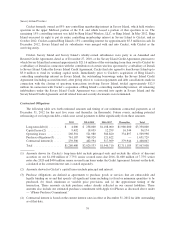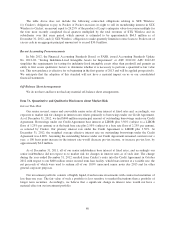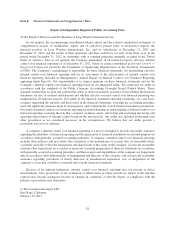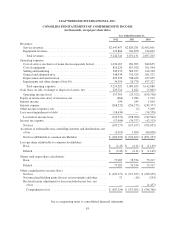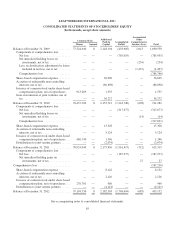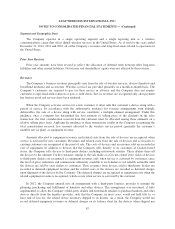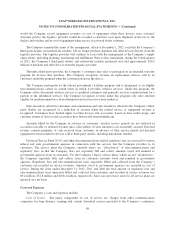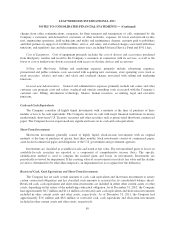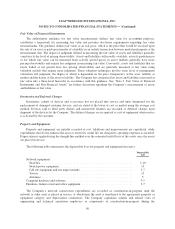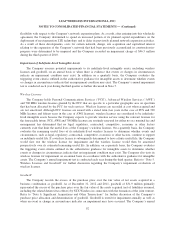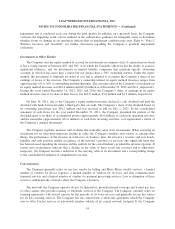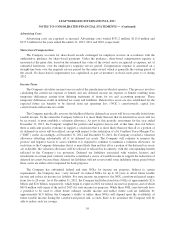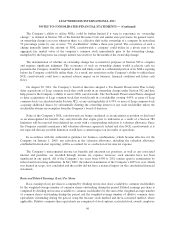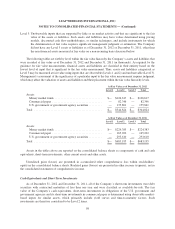Cricket Wireless 2012 Annual Report Download - page 103
Download and view the complete annual report
Please find page 103 of the 2012 Cricket Wireless annual report below. You can navigate through the pages in the report by either clicking on the pages listed below, or by using the keyword search tool below to find specific information within the annual report.LEAP WIRELESS INTERNATIONAL, INC.
NOTES TO CONSOLIDATED FINANCIAL STATEMENTS — (Continued)
charges from other communications companies for their transport and termination of calls originated by the
Company’s customers and destined for customers of other networks; expenses for tower and network facility
rent, engineering operations, field technicians and utility and maintenance charges; amounts paid to publishers
and label partners in support of our Muve Music service, and salary and overhead charges associated with these
functions; and regulatory fees and telecommunications taxes, including Universal Service Fund and E-911 fees.
Cost of Equipment. Cost of equipment primarily includes the cost of devices and accessories purchased
from third-party vendors and resold to the Company’s customers in connection with its services, as well as the
lower of cost or market write-downs associated with excess or obsolete devices and accessories.
Selling and Marketing. Selling and marketing expenses primarily include advertising expenses,
promotional and public relations costs associated with acquiring new customers, store operating costs (such as
retail associates’ salaries and rent), and salary and overhead charges associated with selling and marketing
functions.
General and Administrative. General and administrative expenses primarily include call center and other
customer care program costs and salary, overhead and outside consulting costs associated with the Company’s
customer care, billing, information technology, finance, human resources, accounting, legal and executive
functions.
Cash and Cash Equivalents
The Company considers all highly liquid investments with a maturity at the time of purchase of three
months or less to be cash equivalents. The Company invests its cash with major financial institutions in money
market funds, short-term U.S. Treasury securities and other securities such as prime-rated short-term commercial
paper. The Company has not experienced any significant losses on its cash and cash equivalents.
Short-Term Investments
Short-term investments generally consist of highly liquid, fixed-income investments with an original
maturity at the time of purchase of greater than three months. Such investments consist of commercial paper,
asset-backed commercial paper and obligations of the U.S. government and government agencies.
Investments are classified as available-for-sale and stated at fair value. The net unrealized gains or losses on
available-for-sale securities are reported as a component of comprehensive income (loss). The specific
identification method is used to compute the realized gains and losses on investments. Investments are
periodically reviewed for impairment. If the carrying value of an investment exceeds its fair value and the decline
in value is determined to be other-than-temporary, an impairment loss is recognized for the difference.
Restricted Cash, Cash Equivalents and Short-Term Investments
The Company has set aside certain amounts of cash, cash equivalents and short term investments to satisfy
certain contractual obligations and has classified such amounts as restricted in its consolidated balance sheets.
Restricted cash, cash equivalents and short-term investments are included in either other current assets or other
assets, depending on the nature of the underlying contractual obligation. As of December 31, 2012, the Company
had approximately $0.7 million and $11.4 million of restricted cash, cash equivalents and short-term investments
included in other current assets and other assets, respectively. As of December 31, 2011, the Company had
approximately $3.6 million and $8.8 million of restricted cash, cash equivalents and short-term investments
included in other current assets and other assets, respectively.
89


